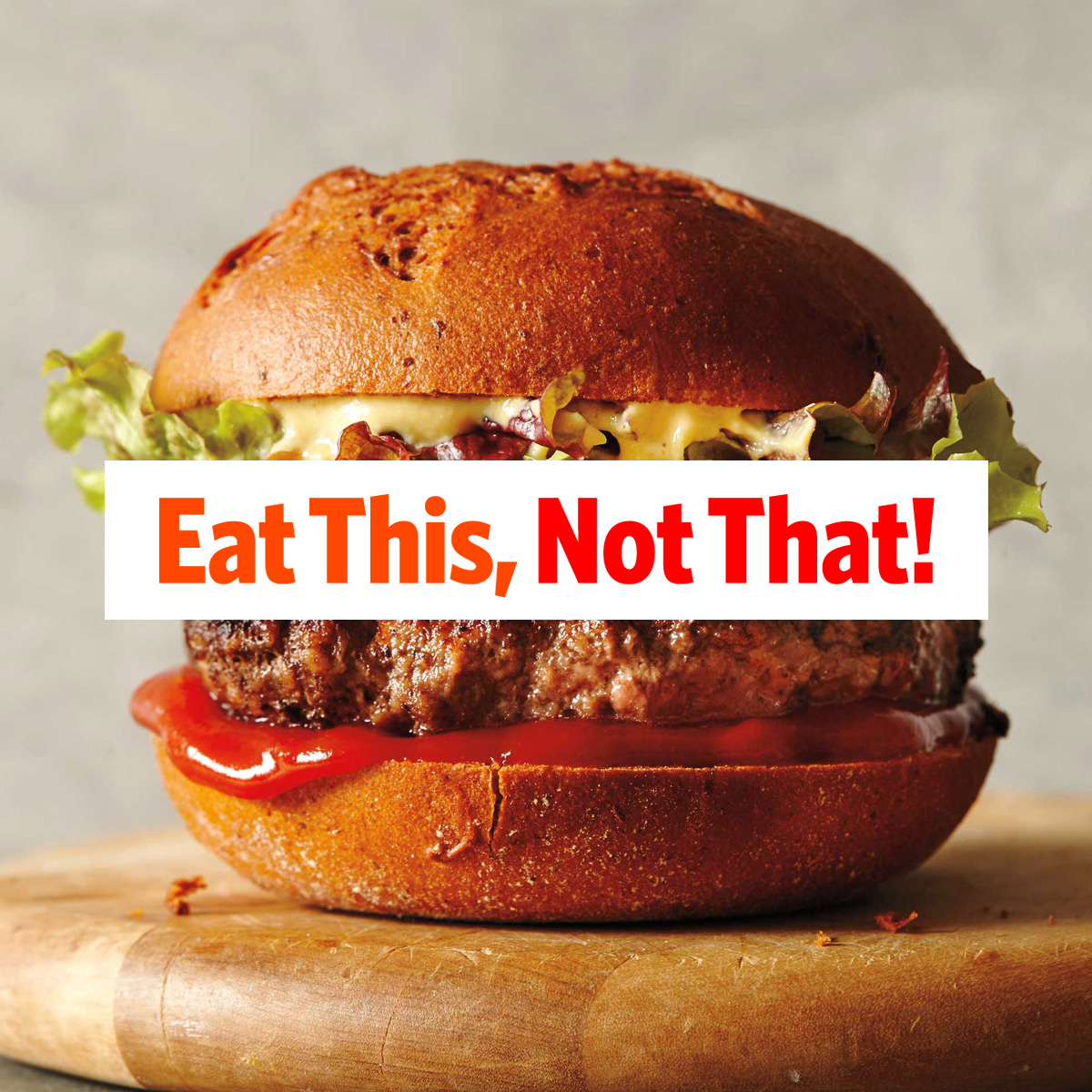When you choose which beer to indulge in at the end of a long day or while you are hanging out with a few friends on the weekend, you likely let the taste of the beverage guide your decision. Of course, you might also be swayed by your loyalty to a certain brand or be drawn in by snazzy art on the can. All are totally reasonable and relatable reasons. At the same time, you might want to consider how many calories are in each particular brew. And if you’re trying to be more conscientious about your diet, you may want to opt for a crisp, cold low-calorie beer.
Frankly, when it comes to alcohol-related weight gain—yes, we’re referring to the infamous beer belly—Harvard Health Publishing points out that the issue has to do with calories. More specifically, consuming more than you burn off every time you grab a beer. And like it or not, when it comes to calories, that happens to be something that beer usually has a fair share of.
To provide you with a little context, if you order a 12-ounce can of beer at your local bar that has an alcohol content of 4%, then it will reportedly contain zero grams of fat, 2 grams of protein, and 13 grams of carbohydrates It will also have 153 calories. However, if the beer you prefer has a higher alcohol content than 4%, then it will also contain more calories. Indeed, as the alcohol content goes up, so does the number of calories. For instance, the National Library of Medicine’s MedlinePlus notes that some high-alcohol beer, as well as some craft beer, can contain anywhere from a relatively high 170 calories to a staggering 350 calories per serving. (Yowza!)
That may surprise you and make you curious about how many calories you’ve been unknowingly consuming whenever you try to kick back and relax with a cold beverage. That’s also why you may want to start paying attention to what’s in your beer, especially if you need to keep track of your calories for various health reasons. This can help you avoid calorie-packed options if necessary and give you a chance to figure out what choices you can enjoy without worry.
With that in mind, you’ll definitely want to check out the following suggestions from dietitians who tell Eat This, Not That! they are the best low-calorie beers that you should definitely give a try. Cheers! Or, salud, santé, and prost, depending on which beer you end up preferring.
1. Light Lager
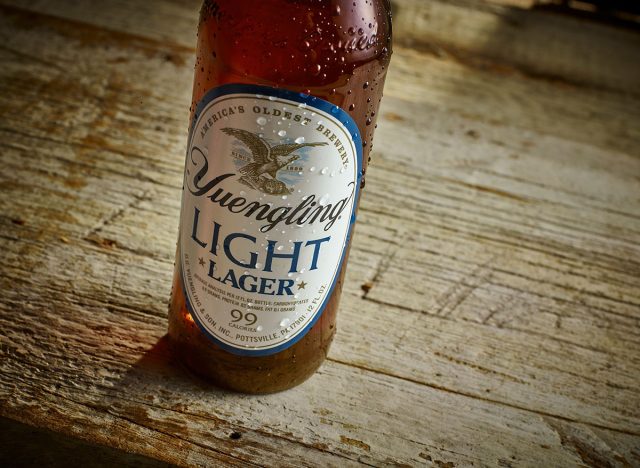
Calorie Count: 90-110 calories per 12-ounce serving
If you adore a luscious lager and don’t want to give up that taste but want to cut back on calories, then you may want to simply consider switching to a light lager. Often a premium lager, American versions tend to have a lower alcohol content, according to Craft Beer Club. Those made in Europe usually have even less alcohol but may be more flavorful. That’s not to mention craft light lagers that aim for a fresh taste that doesn’t rely on heavy flavor.
Whether you’re a fan of American, European, or craft lagers, “”Light lagers tend to have fewer calories and carbohydrates than regular lagers,” Meaghan Greenwood, RD, health coach at HourglassWaist.com.au, tells Eat This, Not That!
2. Pale Lager
Calorie Count: 130-140 per 12-ounce serving
While light lagers are apparently a popular low-cal option, pale lagers are a relatively new addition to the scene, according to CraftBeer.com. Of course, they’re now seemingly just as trendy which is why you might have seen your friends enjoying a pint of it.
If you’re wondering what the difference is between light and pale lager, Charleston Beer Works explains that light lagers opt to lower their calorie count by using fewer hops and barley. On the other hand, pale lagers increase the amount of carbonation while also featuring a pale color and light body as well as a taste that’s not heavy in any way. (Yum!)
Despite being different, when it comes to looks and taste, both options are low in calories. This is is why “they’re an ideal choice,” says Nicole Swingle, RD.
3. Pilsner
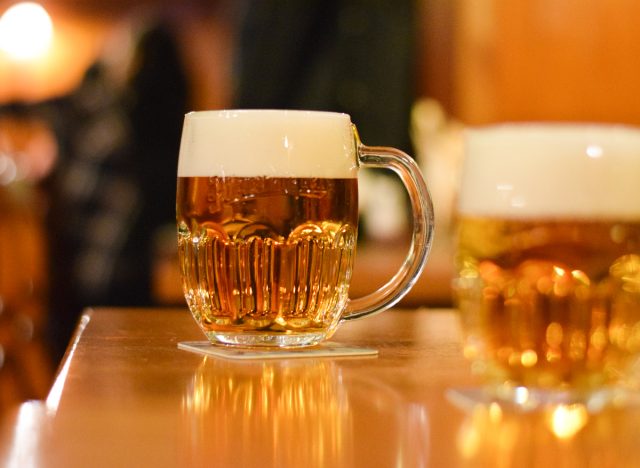
Calorie Count: 65-95 per 12-ounce serving
When it comes to pilsners, Greenwood explains that they are a kind of lager that “tends to be light-bodied, refreshing, and have a crisp finish,” which certainly sounds oh-so-good. Often confused with other lagers due to the fact that companies opt to use the terms loosely in some cases, The Spruce Eats notes that “[t]he key point to remember is that all pilsners are lagers, but pilsner is just one style of beer within the lager family, which includes dark and amber beers as well.”
With an easily recognizable appearance and a familiar flavor that lager lovers surely appreciate, you might also be pleased to find out that they’re a low calorie beer option, with just 65-95 calories per 12 ounces.
4. Dry Stout or Irish Stout
Calorie Count: 125 per 12-ounce serving
Anyone who loves a good Guinness knows about stouts. As for a dry stout or an Irish stout, it’s a drink that is dark and creamy. It also relies on lactose or oatmeal for its specific flavor, according to Brew HQ.
On top of that, “dry stouts are generally lower in calories as far as beers go,” says Jesse Feder, CPT, RD, and a contributor at My Crohns and Colitis Team. “Additionally, alcohol by volume or ABV is a good way to tell if a beer is high in calories or not. The higher the ABV the more calories the beer will usually have.”
5. Wheat Beer
Calorie Count: 100-120 per 12-ounce serving
“Wheat beers tend to be lighter and less bitter than traditional beers,” Greenwood says while discussing another tasty low-calorie option that you may want to order the next time you are eager to enjoy something frosty and frothy. Wheat beers also have an alcohol content level that tends to be on the lower side, according to The Spruce Eats.
Earning its name thanks to the fact that it’s brewed with 30% wheat or more, some are also brewed along with hops while others leave them out. Different versions of wheat beer can also differ in their appearance meaning they can either be clear or somewhat cloudy. You may want to try a few to find the perfect one for you.
6. Blonde Ale or Golden Ale
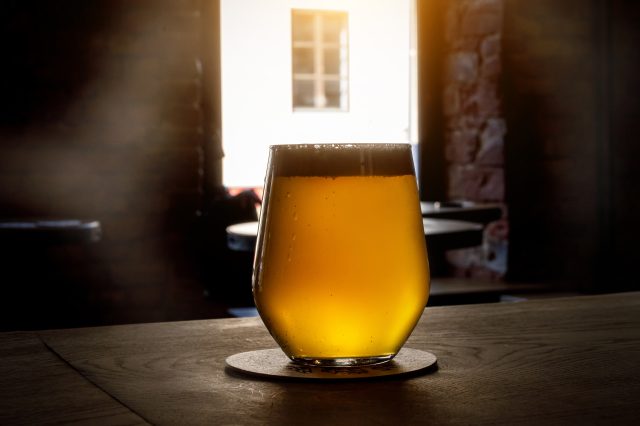
Calorie Count: 95-125 per 12-ounce serving
If you like the idea of a boozy beverage that’s on the lighter side, then you might want to give a nice blonde ale a try. Or, as it’s sometimes known, a golden ale which definitely sounds posh. “Blonde ales tend to be light and easy drinking, making them a great low-calorie beer option,” Greenwood says.
“One of the most approachable styles,” according to CraftBeer.com, it’s a rather simple ale that doesn’t have a strong sense of malt or hops, but instead features a smooth taste that can sometimes include fruits or spices. That makes them an incredibly delicious low-calorie beer choice.
7. Sour Beer
Calorie Count: 140 per 12-ounce serving
“[A] ‘sour beer’ is any beer where acidity forms the backbone of the beer’s flavor structure,” Garrett Oliver, brewmaster at Brooklyn Brewery, explained to Food & Wine. “For most beers that role is occupied by hop bitterness, which acts like tannins in red wine. Sour beers have a structure more like white wine, with acid in the center.” Did you catch that, white wine drinkers? This could be just the right choice for your palette.
Indeed, the resulting taste is, in part, why sour beer might become your new favorite. It also doesn’t hurt that it can be a reasonable option calorie-wise. “Sour beers are a bit of a wildcard when it comes to calories as they can vary widely depending on the specific beer,” Greenwood says. “However, some sour beers can be a lower-calorie option.”
8. Saison
Calorie Count: 150-170 per 12-ounce serving
“This type of beer is often light and effervescent, with a lower alcohol content and calorie count than other types of beer,” Kieran McSorley, RD, at Brentwood Physiotherapy in Calgary, tells Eat This, Not That! Indeed, saisons tend to range from around 150-170 calories per 12-ounce serving ,which isn’t too shabby at all.
If you’ve never tried a saison, Jason Yester, the owner of Colorado’s Trinity Brewing Company, told Craft Beer and Brewing that “[p]ale ale is a good association of how the body should feel on a saison.” If you’re not quite sure what that might mean, he clarified by saying, “It should be very, very light.”
9. Kölsch

Calorie Count: 120 per 12-ounce serving
Usually containing around 120 calories per 12-ounce serving, Kölsch is “definitely an option that you should consider if you’re looking for a low-cal alternative to your regular beer,” Mary Sabat MS, RDN, LD, tells Eat This, Not That!
A rather unique creation, Kölsch is a hybrid, according to CraftBeer.com. That’s due to both the process that’s used to brew it and the eventual product which embraces appealing aspects of lagers and ales. That’s right, you get the best of both worlds and fewer calories!
10. Lambic or American Spontaneous Beer
Calorie Count: 140 per 12-ounce serving
Sabat also suggests trying a lambic beer if you’d like to sip on something that boasts a lot of flavor but not a lot of calories. Also known as an American Spontaneous beer when made in the United States as opposed to its country of origin, Belgium, Levi Funk, the founder and Blender of Funk Factory Geuzeria in Madison, WI, explained the somewhat complicated and layered nature of the brew, telling Hop Culture, “You want a funky, musty, barnyard, and cellar dirt flavor and aroma, but you also want this bright citrus-lemon component. You want some acidity.”
“It’s complex just like everything else about this beer,” Jason Perkins, brewmaster at Allagash Brewing Co. in Portland, ME, also told Hop Culture. “You’ll get different flavors at different times of aging, so an eight-to-12-month-old lambic can taste like a rough around the edges hefeweizen while a two-to-three-year-old lambic starts to develop more tartness and you get that barnyard funk, horse blanket, but also some nice fruity components.”
11. Zero-Proof Beer
Calorie Count: 70 per 12-ounce serving
“Although not a true ‘beer,’ a new trend is zero-proof drinks,” Swingle says. “A zero-proof beer would be distilled beer to 0.0 alcohol with the hop and malt flavors but has significantly fewer calories at around 70 calories.”
However, it’s important to know that “most non-alcoholic beers actually aren’t alcohol-free,” Katie MacBride noted while writing for Healthline. She explained that “[i]n the United States, anything that’s less than 0.5 percent alcohol by volume (ABV) can be labeled ‘non-alcoholic.'” She also pointed out that while “[m]ost regular beer has an alcohol content of around 5 percent ABV,” alcohol-free beer can have 0.4 percent ABV.
Although that’s a relatively low amount, you may want to double-check both the alcohol content and the number of calories in the beer before you grab a can, bottle, or case.
12. Session IPA
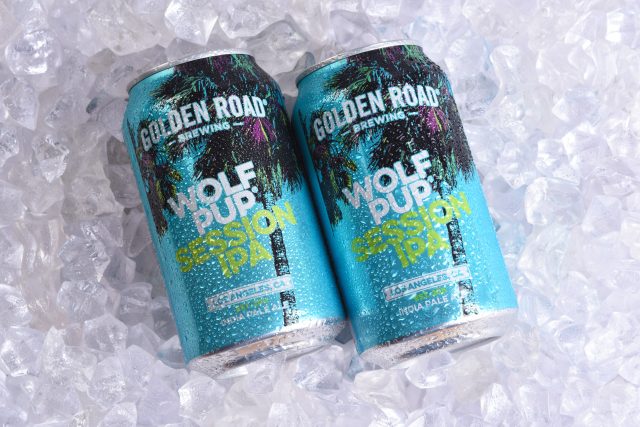
Calorie Count: 100-150 per 12-ounce serving
“Typically, a regular IPA falls anywhere from six-and-a-half to almost eight percent alcohol, so they would not be considered sessionable,” Mitch Steele, the brewmaster and COO at New Realm Brewing Company in Atlanta, told Beau’s All Natural Brewing Company. Because of that, he added, “Usually, you have one pint, maybe two, and you’re done.”
“A session IPA takes the session beer concept, but would still have all of the hop character of a stronger IPA,” Steele explained. “It would have all of the hop flavor — the dry-hopping rates would be at the same level — so the hop intensity and floral, citrus, and fruity characters from the hops would be the same as a regular IPA but you could drink a couple of pints.”
You might also be able to enjoy those extra pints because, as Greenwood points out, “session IPAs tend to have a lower alcohol content and, therefore, fewer calories than traditional IPAs.”
